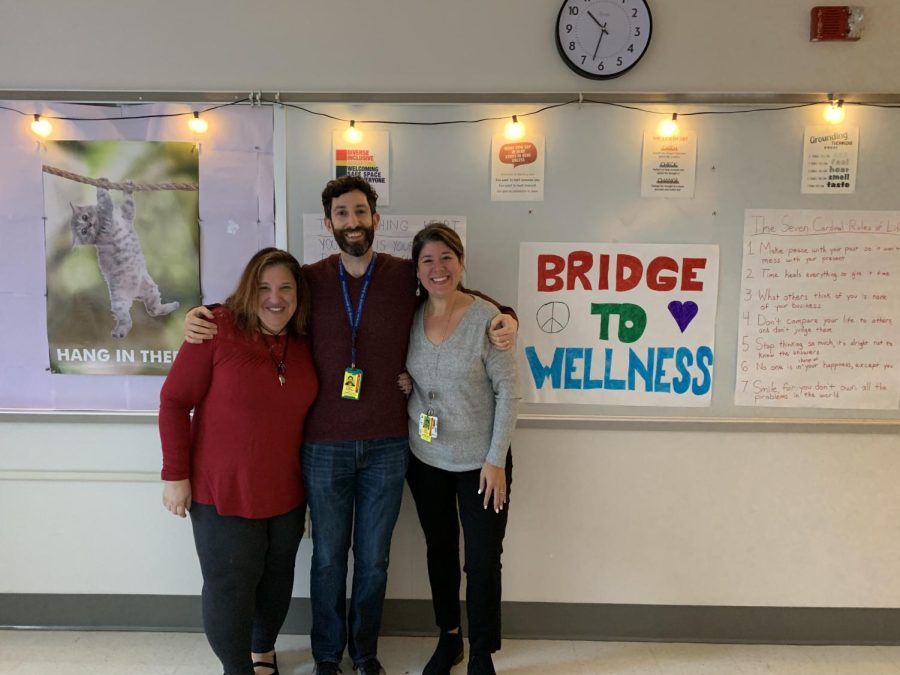Bridge to Wellness connects students to positive mental health
The three members of the Bridge to Wellness team, Maria Bruno, Alex Metral, and Dominic Elliot, stand in front of their “Bridge to Wellness” room poster.
March 21, 2023
$8,000,000: the Montgomery County Council’s special appropriations for expanding High School Wellness Centers (HSWCs) into every MCPS high school. Although Montgomery County has attempted a wide variety of programs meant to address students’ mental health in recent years, this particular venture was notable for both its ambition and timeliness.
Although similar in name, these new wellness centers differ from the pre-existing School Based Health and Wellness Centers (SBHWCs), which offer preventive medical health care, sick care and social services. Instead of physical health, they focus more proactively on mental health.
At WCHS, the wellness center, otherwise known as the Bridge to Wellness (BTW) Room, was opened last fall in collaboration with the county-wide BTW program, which aims to expand access to mental health resources and services. The WCHS BTW team is composed of mental health specialist Maria Bruno, care management manager Alex Metral and youth development specialist Dominic Elliott.
“Since the pandemic, there has been a tremendous need for mental health support, especially in the school community,” the BTW team said. “The BTW Program was brought to WCHS to address the mental health needs of students dealing with social-emotional issues such as anxiety, depression and stress.”
WCHS is a prime example of how high academic standards often lead to invisible lacerations, harming students’ social, emotional and mental health. In particular, as students reach significant turning points throughout the year, such as the end of the first semester, the start of AP exam season and SAT days, stress levels can rise exponentially.
“The most stressful thing about school is the academic competition,” WCHS junior Hanan Ali said. “There is such a toxic culture with the hard classes you are taking and what you got on this or that test. The Wellness Center has helped so much by being somewhere I can tell no one cares about my grades.”
The largest perk of the room is that it is open all throughout the school day to anyone who needs support. Regardless of when or why they visit, the wellness center strives to be an inviting space where all students are free to be themselves.
“During one of the half days, I wanted a comfortable environment to meet new people and relax,” Ali said. “When I walked in, both the overall vibes and everyone there was so cool; I remember there was an open mic and people were reading out jokes. I’ve gone back so many times since then because I just really love that environment.”
Whereas the other school resources for students are more traditional such as the counseling office’s academic support, the wellness center tackles students’ stress differently: by meeting them where their interests lay.
“During lunch, we host different activities for students like e-sports tournaments, topical debates, and an open mic where students can perform or listen to others perform,” the team said. “The BTW Room also hosts groups where students can develop skills and get to know their peers better.”
There may be those who question the effectiveness of these activities in addressing mental health; after all, these are arguably unorthodox methods that differ from the school mental health measures that students are used to. However, unconventional does not mean unsuccessful.
“The video games help students to connect with others as well as relax, and the open mic gives students a chance to express themselves and hear peer feedback,” the team said. “It is a wonderful way to build self-esteem.”
In addition to group activities, the members of the team work in their respective areas of expertise to implement specialized resources. As the mental health specialist, Bruno works with both students and families for more targeted supportive counseling. With her goal being to help those with diverse needs who need more mental health support than they are able to receive through the traditional school support pipeline, she runs various student groups on topics such as coping skills.
As the youth development specialist, Elliott identifies as a “jack of all trades.” From help with math to the development of time management skills, he offers support with whatever a student’s individual needs may be. In keeping with the wellness center’s focus on community, he also hosts group activities that foster discussion and teamwork.
Although these two roles focus primarily on helping students directly with their social and emotional well-being, the wellness center’s reach extends beyond that. As the care management manager, Metral works to support students’ external needs outside of the school environment.
“My role is to link students and families to resources within the community,” Metral said. “These resources may include outside mental health providers, clothing or food, housing and rental assistance, and assistance with insurance or benefits applications.”
With the combination of group and individual support, the wellness center has proven to be a valuable asset that supplements the work of the WCHS counselors, psychologist and social worker. The BTW team hopes to continue to draw a wider audience, emphasizing that there is no specific kind of student that the room’s resources are designed for.
“Since most people at some point in their lives deal with depression, anxiety and stress, we are open to all students who need support,” the team said. “We are [always] available to talk with students about anything that is on their minds and provide guidance.”



